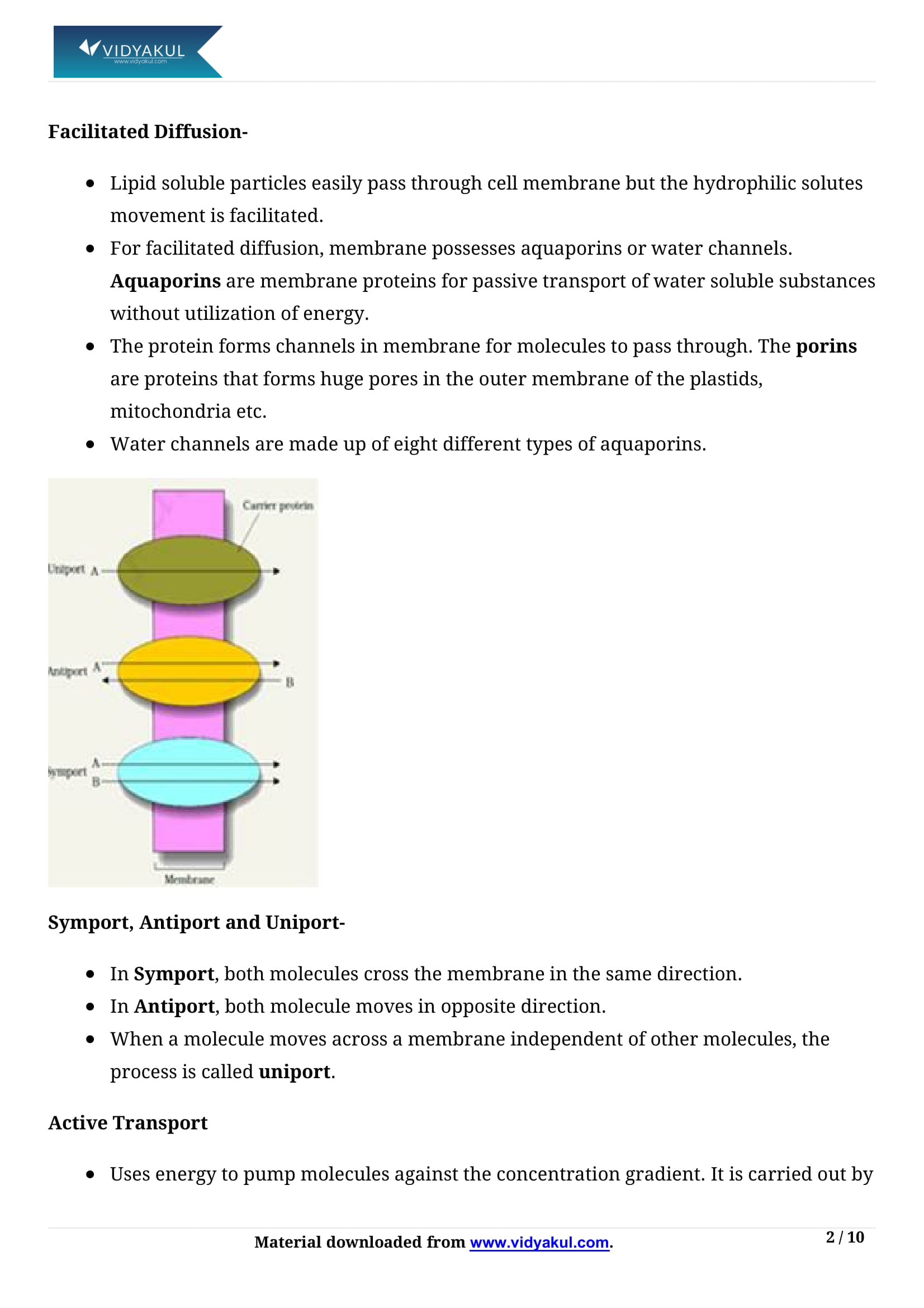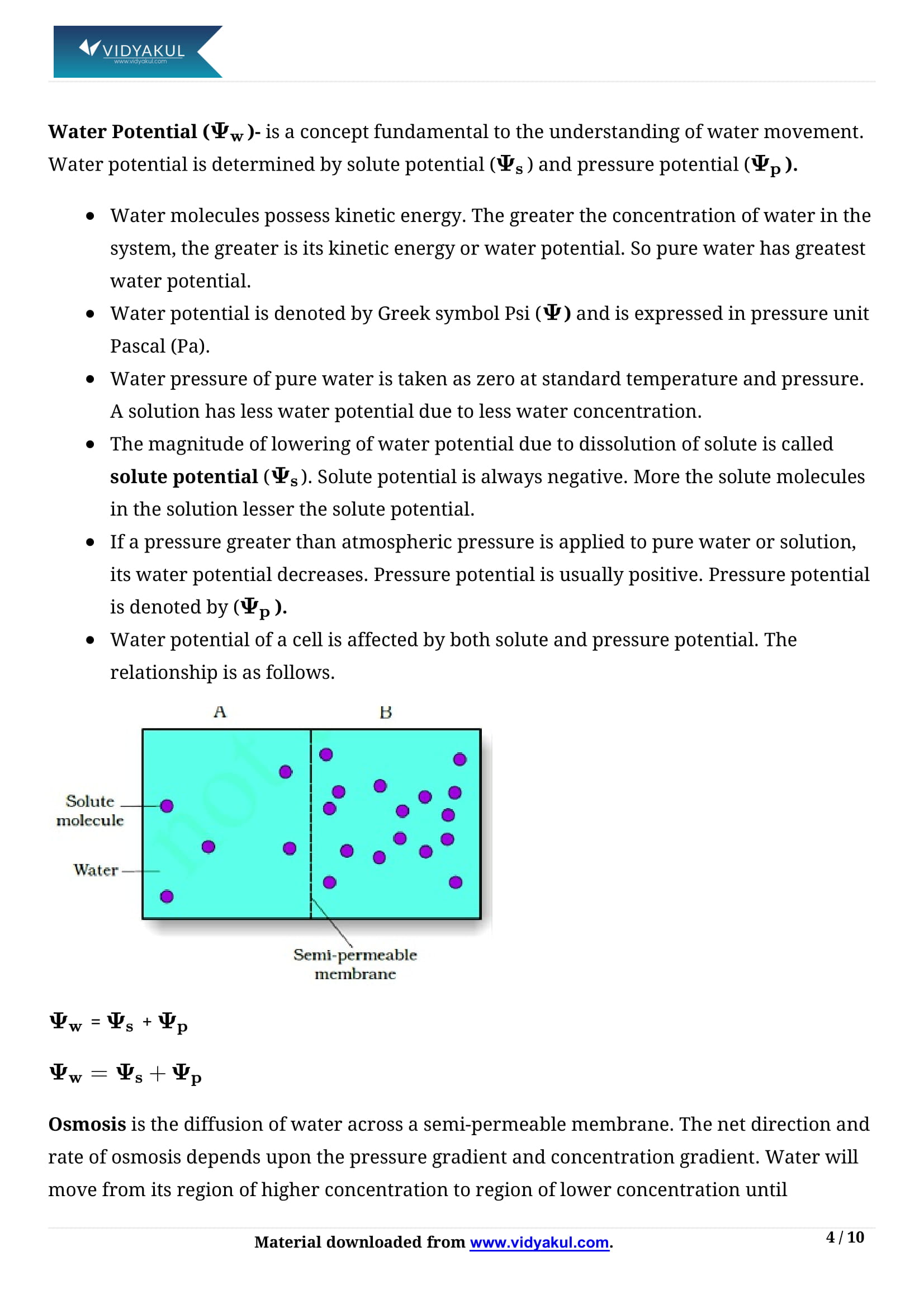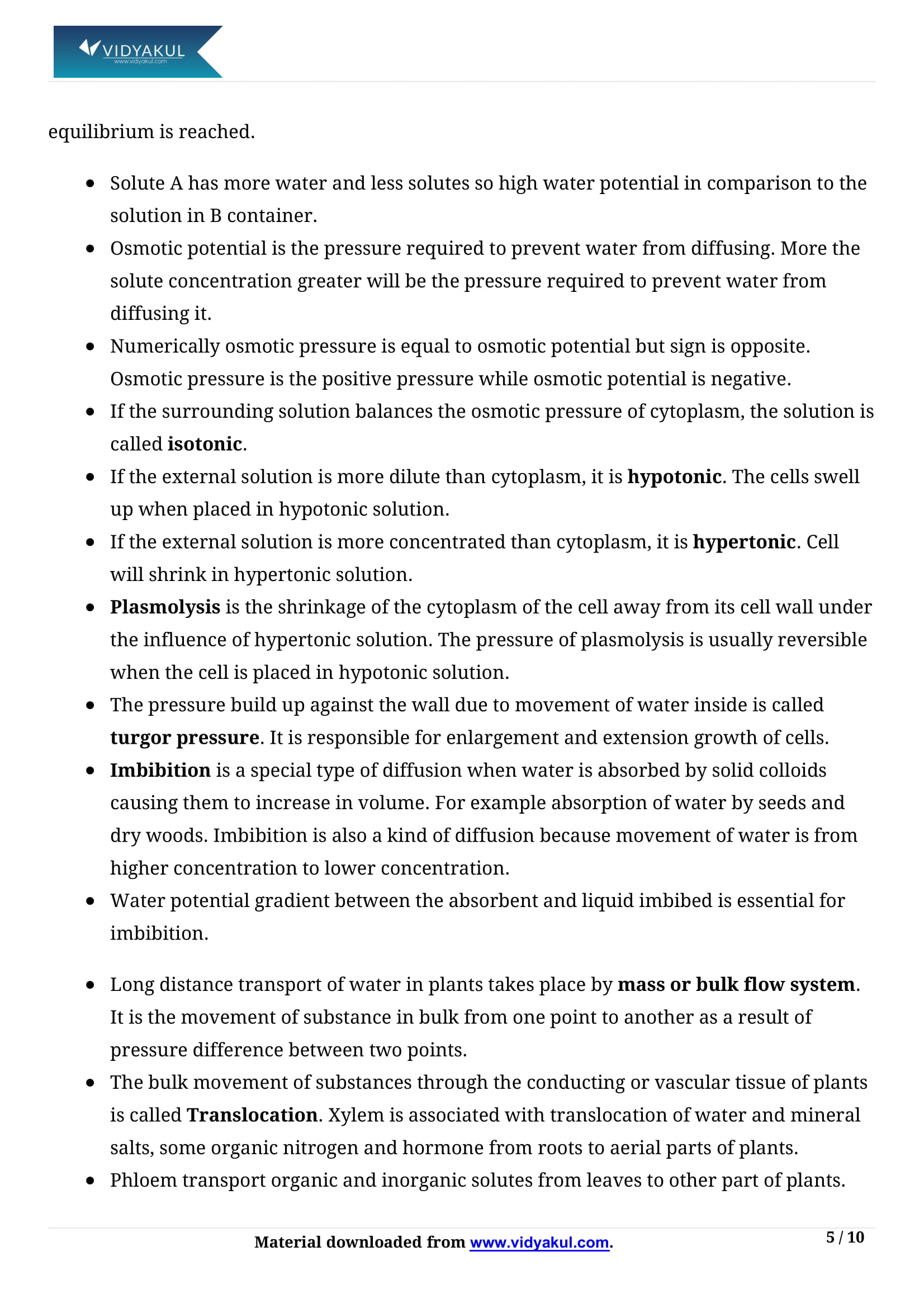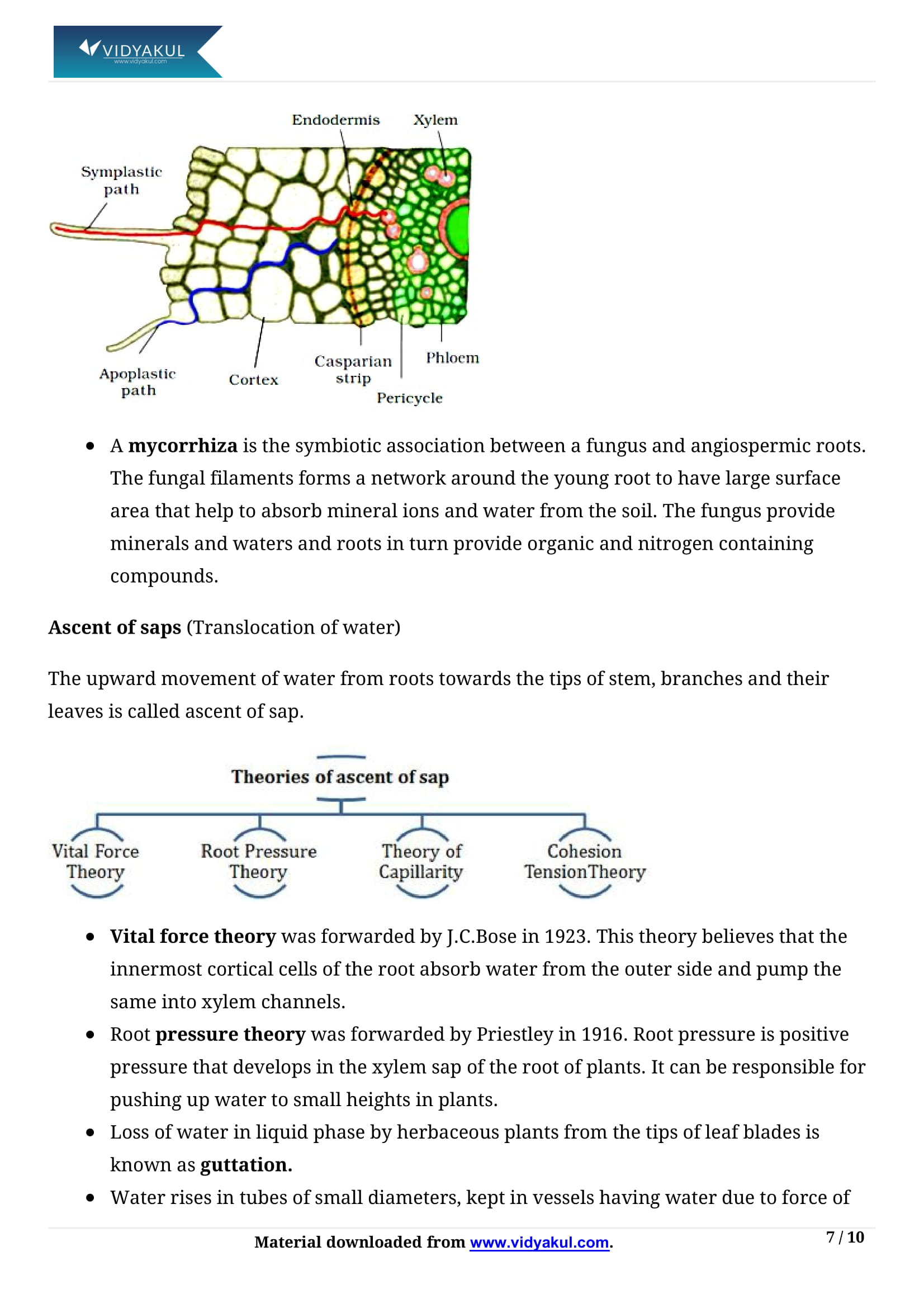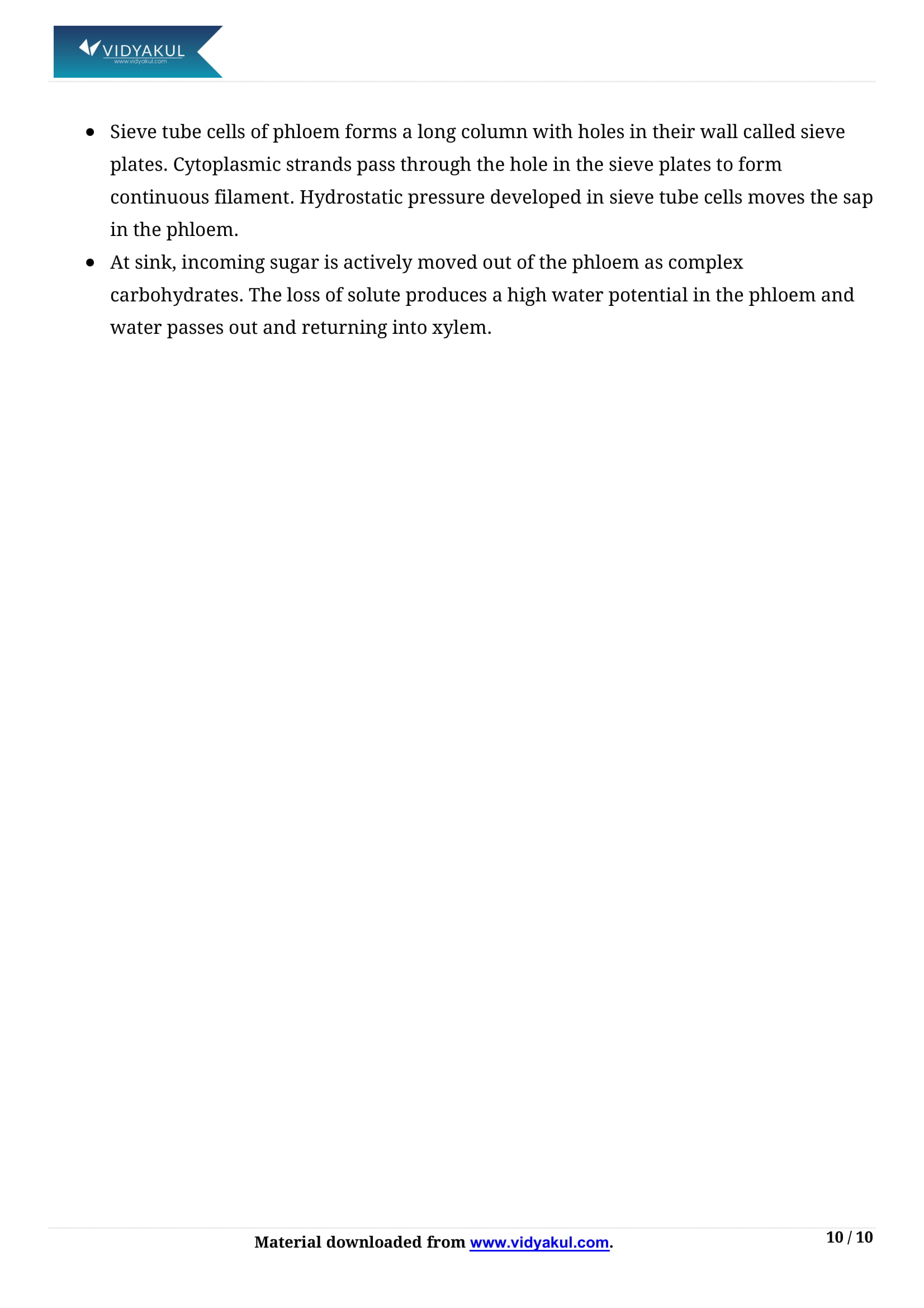Transport in Plants Class 11 Notes

Chapter 11 Transport in Plants
NCERT Class 11 Biology covers plant transport concepts. Students can find notes to Chapter 11 of Year 11 Biology on Vidyakul. These notes make it easy for students to complete assignments. NCERT Class 11 biological notes is based on the latest CBSE program.
Vidyakul subject matter experts provide CBSE Class 11 Biology NCERT notes. Students can use the NCERT Class 11 Biology notes anytime online atVidyakul. In addition to the NCERT notes, Vidyakul provides over 150 practical questions about factory transport free of charge, based on 59 common concepts.
CBSE CLASS 11 BIOLOGY CH-11
Points to Remember
While studying, the important points to remember from the chapter are as follows:
1. Means of Transport:
(i) Plants get a variety of inorganic elements (ions) and salts from their surroundings, especially from water and soil.
(ii) The movement of these nutrients from the environment into the plant and from one plant cell to another essentially involves movement across a cell membrane.
(iii) Transport across cell membranes can be through diffusion, facilitated transport or active transport.
(iv) In facilitated diffusion, special proteins called porins help transport and are called carriers.
(v) Passive transport (diffusion, osmosis) and active transport are the two modes of nutrient transport across cell membranes in living organisms.
(vi) In passive transport, nutrients move across the membrane by diffusion, without any energy use, as it is always down to the concentration gradient and thus, entropy-driven.
(vii) In plants, the diffusion process is evident in gaseous exchange and transpiration.
(viii) In active transport, energy in the form of ATP is utilised to pump molecules against a concentration gradient across membranes.
2. Plant-Water Relation:
(i) Water potential is the potential energy of water which assists in the movement of water. Water potential is determined by solute potential and pressure potential.
(ii) Osmosis is water movement across a semipermeable membrane which depends on pressure gradient and concentration gradient.
(iii) The cell’s behaviour depends on the external solution. It is normally hypotonic or hypertonic.
(iv) Hypotonic solution causes endosmosis, and hypertonic causes exosmosis.
(v) The highly concentrated external solution give rise to plasmolysis through excessive exosmosis which causes shrinkage of protoplasm.
(vi) Imbibition is a type of diffusion in which the water is absorbed by solid colloids, causing them to increase in volume.
Topics and Sub-topics
Students can refer to Vidyakul's NCERT Class 11 Biology book to reinforce their conceptual understanding in the chapters. In addition to books, students can expand their knowledge using the NCERT notes. NCERT Class 11 notes help students understand concepts easily. Students can practice free questions provided on Vidyakul.
So, students can practice questions and take free exams onVidyakul. It has the best prep tips to help students. Additionally, students should focus on the NCERT notes that benefit them. Vidyakul also makes learning fun for students.
Let us look at the topics that students are going to study in this chapter:
Frequently Asked Questions
Do plants require to adjust the solute types that arrive at the xylem? Name the molecules that assist in adjusting. How is the regulation of the type and quantity of solutes that reach the xylem brought about by the plants?
Yes, adjustment is required. The end dermal cells possess the transport proteins that aid in regulating and adjusting the solute movement. Since soil minerals are present as charged particles with less concentration in comparison to the roots, they all cannot be transported passively across the cell membranes of the root hairs. Hence through passive and active processes minerals are transported to the xylem. On arriving at the xylem, they are further transported towards the sink through the transpiration stream. The mineral ions at the sink region are unloaded through active uptake by receptor cells and diffusion. A few mineral ions that move often through the xylem are:
Nitrogen travels in plants as inorganic ions NO2 and NO3 but much of the nitrogen moves in the form of amino acids and related organic compounds
Minerals ions are frequently remobilized specifically from older senescing pats. Leaves that are old and dying export most of their mineral content to younger leaves. Likewise, before leaves fall in deciduous plants, minerals are eliminated from other parts. A few elements that are readily mobilized are sulphur, phosphorous, potassium and nitrogen.
State differences between permanent and temporary wilting.
Wilting refers to the loss of turgidity of leaves and the other soft aerial parts of a plant that causes folding, dropping and rolling of non-woody plants. It usually takes place when the rate of water loss is higher than the rate at which it is absorbed.
How are halophytes able to display a high precell pressure compared to the atmospheric pressure.
Halophytes require soil with a high concentration of salts to grow. In the cytoplasm, there is an accumulation of salts due to which the osmotic concentration in the cytoplasm is increased that causing the entrance of water into the cells. Hence, the turgor pressure in halophytes cells is higher in comparison. Two steps are adapted by halophytes to restrict it:
In vacuoles, they gather salts away from the cytoplasm
Presence of salt-secreting glands to eliminate excess salts
Classify the following into semipermeable membrane (S.P) and selectively permeable (S.L)
a) Animal Bladder
b) Plasmalemma
c) Tonoplast
d) Parchment membrane
e) Egg membrane
The classification is shown below:
List out the differences between Guttation and Transpiration in plants?
Transpiration and guttation are the two important processes of removal of excess water from plants. Listed below are the major differences between transpiration and guttation.
Practice Questions
Q.1. How does the analysis of the exudate enable one to detect minerals and the form in which they are assembled in the plant?
Q.2. Name a method that can be used to increase the life span of cut plants in a vase.
Q.3. Does the rate of transpiration in different species of a plant cultivated in the same area differ at a particular time? Support your answer.
Q.4. Explain why the intracellular levels of K+ in animal cells are higher than the extracellular levels.
Q.5. Why do cut pieces of beetroot produce colour in hot water and not in cold water?
Do plants require to adjust the solute types that arrive at the xylem? Name the molecules that assist in adjusting. How is the regulation of the type and quantity of solutes that reach the xylem brought about by the plants?
Nitrogen travels in plants as inorganic ions NO2 and NO3 but much of the nitrogen moves in the form of amino acids and related organic compounds
Minerals ions are frequently remobilized specifically from older senescing pats. Leaves that are old and dying export most of their mineral content to younger leaves. Likewise, before leaves fall in deciduous plants, minerals are eliminated from other parts. A few elements that are readily mobilized are sulphur, phosphorous, potassium and nitrogen.
State differences between permanent and temporary wilting.
How are halophytes able to display a high precell pressure compared to the atmospheric pressure.
In vacuoles, they gather salts away from the cytoplasm
Presence of salt-secreting glands to eliminate excess salts
Classify the following into semipermeable membrane (S.P) and selectively permeable (S.L)
List out the differences between Guttation and Transpiration in plants?
Learn More about the same in Transport in Plants Class 11 Notes PDF.
Download this solution for FREE Download this PDF
Download Vidyakul App for more Important videos, PDF's and Free video lectures.

